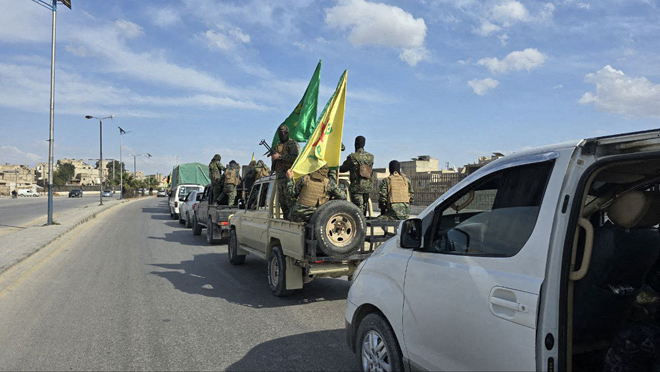Does the “Laboratory” of Sheikh Maqsoud and Ashrafiyeh Suit the Rest of Syria?
By Shoresh Darwish
In the second day of the arrival of the “Deterrence of Aggression” operation to Aleppo, the Autonomous Administration requested the entry of aid consisting of shipments of medicine and fuel for the besieged neighborhoods of Sheikh Maqsoud and Ashrafieh. The Assad regime, in one of its weakest moments, responded by demanding financial sums to facilitate the aid passage to the two neighborhoods. This last image of the regime revealed its corrupt behavior in its final hours and how it deals with the resilient and besieged Kurdish neighborhoods in Aleppo. However, it also exposed the regime’s arrogance and its belief that every war it fights or is fought against it is merely a temporary round, and that it will eventually return to its original ways.
On paper, maintaining the Kurdish neighborhoods in Aleppo for over a decade amid complex military and sectarian conflicts seemed like an impossible gamble. These neighborhoods have faced various military assaults, especially from Turkey-aligned militants who bombarded them with rockets and primitive “Hell” missiles, and imposed stages of blockade that they exchanged with the Assad regime. Preserving the Kurdish enclaves in Aleppo required more difficult efforts after Afrin was occupied by Turkey in early 2018, as the demographic pressure on these neighborhoods became greater, making the requirements for self-administration more challenging, especially with the regime imposing taxes and tariffs on goods and commodities in the Kurdish neighborhoods, alongside forms of psychological blockade and harassment of the residents. The regime’s treatment of the self-administration for the two neighborhoods resembled an excerpt from its intervention in Lebanon, but with the difference that it treated them as an internal occupation purely that sees the residents as material for political blackmail and enriching its close military officers. In contrast to the ongoing repressive policies towards the Kurdish neighborhoods, the self-administration found itself, in Al-Qamishli and Al-Hasakah, engaged in tightening the noose around the “military consulates of the regime” known as the security squares, as this tightening in Al- Hasakah aimed to loosen the regime’s grip in Aleppo.
With Aleppo falling out of the regime’s hands, the Kurdish fighters briefly expanded their control within the city and seized Aleppo International Airport, while defending tens of thousands of displaced people in the Tel Rifaat camps after Turkey, on behalf of its affiliated militias, announced the start of an offensively misleadingly named “Dawn of Freedom.” The actual aim was to enter into a subordinate war against the Kurds at a time when the convoys of Hay’at Tahrir al-Sham were heading south towards the interior cities. Within this new outbreak of open warfare, it seemed that the task of removing the Kurds from the heart of the post-Assad scene was difficult after all advances by Turkish-affiliated militias in the vicinity of the Tishrin Dam were halted. The changing maps of control kept the Kurdish neighborhoods in Aleppo under the threat of renewed battles in them, as these neighborhoods remained the last areas that enjoyed self-protection without any cover from the international coalition, amidst a lack of balance of power, with the Russian presence and multiple actors emphasizing the state of “armed peace” that characterized the situation in Aleppo since 2018. Naturally, rumors circulated at the end of March regarding the readiness of Turkey-affiliated militias to wage war on Sheikh Maqsoud and Ashrafiyeh, which can be viewed as a continuation of the psychological warfare against those inside these neighborhoods and against all Kurds, something that the Syrian Democratic Forces (SDF) experienced throughout years of armed conflict in Syria.
At the beginning of this month, the Civil Council for the two Kurdish neighborhoods signed an agreement with Damascus that recognized the social and cultural specificity of Sheikh Maqsoud and Ashrafiyeh. This agreement tasked the Internal Security Forces (“Asayish”) and the Ministry of Interior with the security of the neighborhoods, while military forces withdrew to the east of the Euphrates and prisons were cleared, granting the neighborhoods full and fair representation in the provincial council, as well as representation in the chambers of commerce and industry. It also included maintaining service, administrative, educational, and municipal institutions until the joint central committees can agree on a sustainable solution. This means the full implementation of the agreement depends on the developments in the east of the Euphrates and the ability of the joint committees to overcome potential obstacles.
In the backdrop of this scene, two factors contributed to reaching the Aleppo agreement: the first was the “Call for Peace and Democratic Society” launched by Kurdish leader Abdullah Öcalan on February 27, which brought about a cooling of the Turkish war front against the Kurds and allowed Ankara to let Damascus experiment with politically-oriented solutions for the files of northeastern Syria and Kurdish demands. The second was the signing of an understanding paper by General Mazloum Abdi and Ahmed al-Sharaa on March 10, of which the Aleppo agreement is a branch, also involving the return of the displaced to Afrin and Ras Al-Ayn/Sere Kaniye, which has slowly begun to realize in the meantime regarding Afrin. A third factor may further complement the previous points: the difficulty of removing the SDF from the heart of the Syrian political and military scene for several reasons.
What happened in the Kurdish neighborhoods could, if the agreement succeeds and endures, serve as a precursor to establishing a decentralized system across several regions in Syria. If we consider the agreement a preliminary vision for what some matters in northeastern Syria might evolve into, we could say that the nature of the agreement could extend to other Syrian regions like the Jaramana neighborhood in rural Damascus, Wadi al-Nasara in western Homs, and others. If the Aleppo agreement positively influences the east of the Euphrates, it could expand to larger areas like the south and the coast.
Indeed, the experiment in Sheikh Maqsoud and Ashrafiyeh could serve as a precursor to breaking the troubling conceptions surrounding identities seeking dominance and control in the name of political majorities, whether in confined areas like one neighborhood here and another there, or over entire provinces. The Aleppo agreement highlighted the possibility of confronting hegemonic discourse as it stipulated the “social and cultural specificity” of the inhabitants of the two neighborhoods. Conversely, the agreement placed the responsibility for maintaining security on local communities and the Ministry of Interior. This collaborative framework might be ideal for ensuring security in a country where the imaginations of its citizens have been shaped by sectarian killings and terrifying acts of revenge.




Comments are closed.